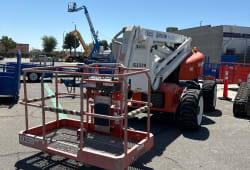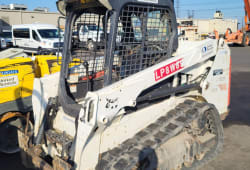Reaching New Heights: Exploring the World of Jib Booms
7 Lectura mínima
)
enero 6, 2024
Forklifts are workhorses, hauling and stacking with tireless efficiency. But sometimes, even their reach falls short. That's where jib booms enter the scene, transforming forklifts into aerial acrobats, extending their capabilities to dizzying new heights and angles. Let's delve into the fascinating world of these industrial extension cords, exploring their types, uses, and how they can revolutionize your operations.
Jib Boom Symphony:
Telescopic Booms: Like musical scales expanding across the stage, these extend and retract in segments, offering variable reach and precise positioning.
Articulating Booms: Imagine bending the notes of a melody – these booms pivot at joints, offering unparalleled maneuverability around obstacles and into tight spaces.
Fixed Booms: Picture a steady bass line – these robust, non-moving jibs provide unwavering lifting power and stability for heavy-duty tasks
A Chorus of Applications:
Jib booms aren't just for showboating – they're versatile workhorses, excelling in diverse tasks like:
Construction: Placing steel beams, trusses, and other heavy components with pinpoint accuracy.
Manufacturing: Feeding production lines, repositioning machinery, and accessing hard-to-reach areas.
Warehousing: Lifting pallets onto high shelves, retrieving items from upper storage racks, and maneuvering in narrow aisles.
Maintenance: Installing and repairing equipment in buildings, wind turbines, and other tall structures.
Safety Matters:
Just like any high-flying act, safety is paramount with jib booms. Here's how to keep the performance in perfect harmony:
Load Capacity: Never exceed the boom's weight limit – overloading can lead to instability and accidents.
Center of Gravity: Maintain a balanced load distribution to prevent tipping and ensure smooth operation.
Ground Conditions: Choose firm, level surfaces to avoid instability and potential damage to the boom or forklift.
Operator Training: Proper training is crucial for safe and efficient jib boom operation.
Jib booms aren't just attachments – they're game-changers. By understanding their types, applications, and safety considerations, you can unlock a new dimension of productivity and reach in your operations. So, raise the curtain on increased efficiency, precision handling, and access to previously untouchable areas. With the right jib boom, your forklift will be ready to perform a truly unforgettable industrial ballet.
Beyond the Stage:
This is just a starting point for your jib boom exploration. Consider delving deeper into specific topics like:
Advanced features: Remote control, winch attachments, tilt mechanisms.
Safety regulations: Local and industry-specific guidelines for jib boom operation.
Cost-benefit analysis: Evaluating the investment return for your specific needs.
Real-world case studies: How different industries utilize jib booms for efficiency gains.
By diving deeper and tailoring the content to your audience, you can create a truly informative and engaging piece that shines a spotlight on the fascinating world of jib booms and their potential to transform your operations.
Manual vs. Automatic Sweeper Brooms: Dust Collection Options
Manual Sweeper Brooms:
Operated by pushing or manually propelling the sweeper, suitable for smaller areas or spot cleaning.
Dust collection relies on internal brushes that sweep debris into a collection bin or tray.
Generally smaller in size and capacity, requiring frequent emptying but offering agility in tight spaces.
Automatic Sweeper Brooms:
Powered by engines or batteries, ideal for larger areas or continuous cleaning operations.
Dust collection often involves more sophisticated systems, such as vacuum suction or larger-capacity collection bins.
Larger and more efficient, they require less frequent emptying and cover more ground in a single sweep.
Sweeper Brooms for Specific Floor Types and Cleaning Needs
Hard Floors (Tile, Concrete):
Manual sweepers suit smaller hard floor areas, offering quick cleaning and maneuverability in confined spaces.
Automatic sweepers excel in larger hard floor spaces, providing thorough cleaning and efficiency over extended areas.
Carpeted Floors:
Manual sweepers can handle low-pile carpets effectively, offering a gentle clean without damaging the fibers.
Automatic sweepers equipped with adjustable settings are suitable for various carpet pile heights, providing efficient and thorough cleaning.
Outdoor Areas:
Automatic sweepers, with their larger capacities and robust dust collection systems, are preferable for outdoor cleaning, handling debris more effectively.
Manual sweepers can be suitable for smaller outdoor spaces or specific spots that are harder to access with larger equipment.
Dust Collection and Disposal
Manual Sweepers:
Typically have smaller dust collection bins or trays that need frequent emptying, suitable for smaller cleaning tasks.
Dust disposal involves manually removing the debris from the collection bin, requiring direct handling.
Automatic Sweepers:
Offer various dust collection options such as vacuum systems or larger capacity bins that reduce the frequency of emptying.
Some automatic sweepers feature self-cleaning systems or easy-to-empty bins, minimizing direct contact with collected dust and debris.
Selecting between manual and automatic sweeper brooms depends on the area size, cleaning frequency, floor types, and dust collection preferences. Both types have their advantages, offering efficient cleaning solutions tailored to specific cleaning requirements.
Snow Plow Blade Designs for Varied Snow Conditions
Straight Blades:
Versatile and efficient in most snow conditions, including light to moderate snowfall.
Ideal for regular plowing operations on flat surfaces, offering simplicity and ease of use.
V-Shaped Blades:
Suited for handling heavier snow loads and more challenging snow conditions.
Efficiently directs snow to the sides, providing better maneuverability in deeper snow or uneven terrains.
Winged Blades:
Adjustable wings allow for blade width modification, offering versatility in different snow depths.
Effective for both light and heavy snow conditions, providing flexibility in plowing width.
Box Blades:
Designed for pushing larger volumes of snow, often used in extreme snow conditions or for clearing large areas.
Effective in breaking through heavily compacted or icy snow.
Tips for Choosing the Right Snow Plow for Forklifts and Regions
Consider Forklift Compatibility: Ensure the snow plow is compatible with the forklift's weight capacity and attachment mechanisms.
Evaluate Snow Conditions: Select a plow design based on the prevalent snow conditions in your region. For heavy snowfall, opt for V-shaped or winged blades for better maneuverability.
Assess Terrain Type: Consider the terrain where the plow will be used. For uneven or rough surfaces, a V-shaped blade may offer better performance, while flat surfaces may suit straight blades.
Adjustable Features: Look for plows with adjustable features like blade angles or wing adjustments for versatile snow management.
Plow Width and Size: Choose the plow size that matches the forklift's capacity and the area to be cleared. Larger plows handle more snow but may be challenging in tighter spaces.
Durability and Material: Consider the plow's material and durability to withstand frequent use and harsh weather conditions prevalent in your region.
Maintenance and Support: Ensure the availability of maintenance and support services for the chosen snow plow to address any issues or repairs promptly.
Conclusion
Selecting the right snow plow involves a comprehensive evaluation of forklift compatibility, prevailing snow conditions, terrain type, adjustability features, size, durability, and available support services. This ensures efficient snow-clearing operations tailored to your specific needs and region.

Caleb Woods is an experienced content specialist and an editor at Boom & Bucket, blending his journalism background with expertise in the heavy equipment industry. He delivers engaging, informative content to help professionals stay informed and make smarter decisions in the machinery market.











